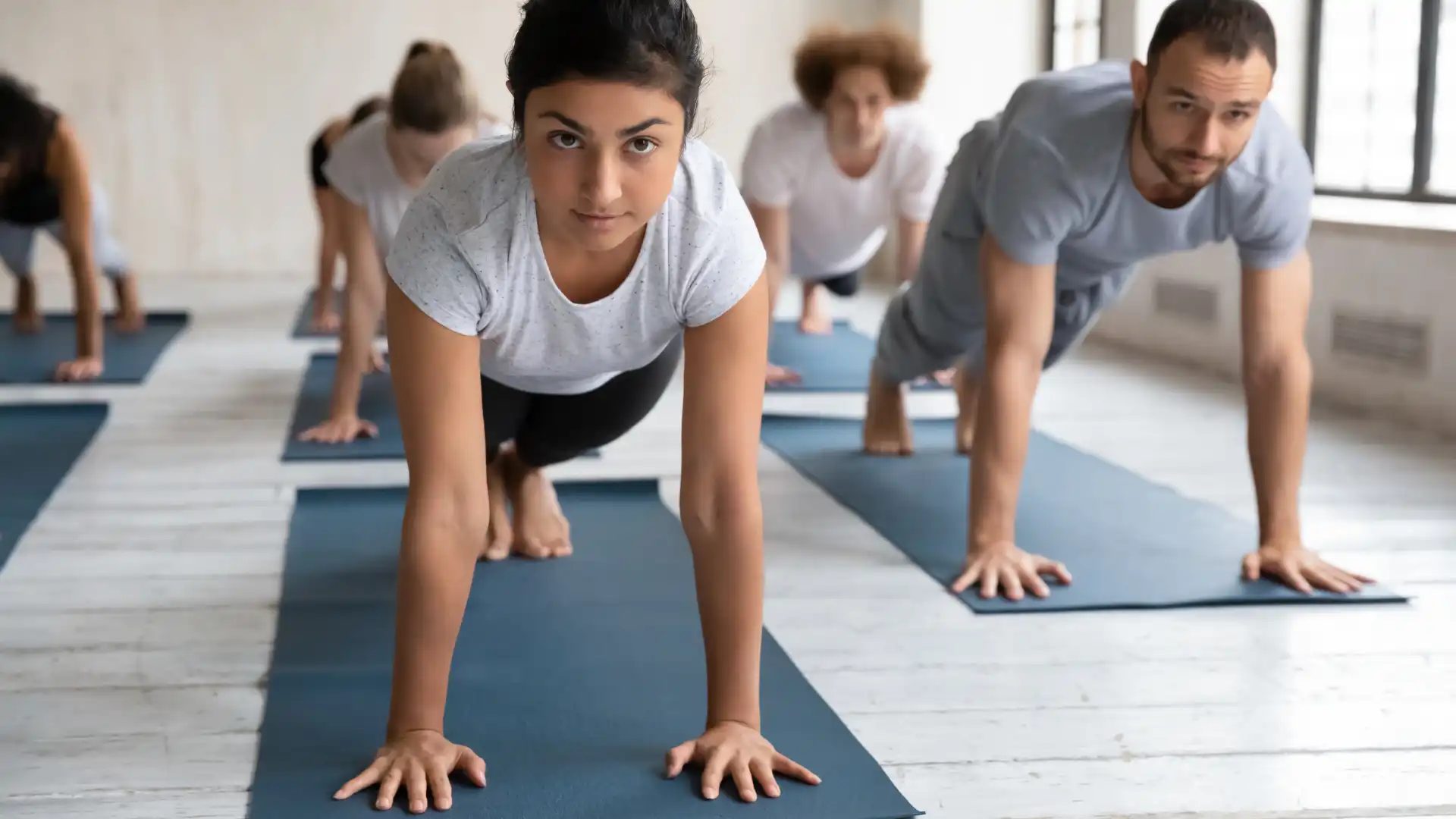Wrist Pain During Yoga? 4 Tricks to Eliminate Discomfort

Article At A Glance
To eliminate pain in poses that require weight-bearing through the wrists, align the poses according to your unique structure. These three alignment tricks will show you how to get there.
Experience wrist pain during yoga? You’re not alone. Wrist pain or discomfort is one of the most common complaints from yoga students (and those are just the ones who speak up!).
Asana practice, especially Vinyasa Flow Yoga, often has many demands on the wrists (a complex and somewhat delicate joint). Between the constant weight bearing on the hands and extensive range of motion (ROM) demanded by the poses, it isn’t surprising wrist soreness or pain is a common part of yoga practice. But it doesn’t have to be.
Wrist Pain in Yoga = Red Flag

Wrist pain of any kind is a red flag, nothing to be overly distressed over (though if persistent, it’s wise to see a doctor), but not something to be ignored either.
As mentioned above, the wrist is a complex joint with multiple bones and articulations that allow movement on two planes: flexion (bending the palm of the hand toward the forearm); extension (raising the back side of the hand up), adduction (bending the wrist toward the little finger when the palm is facing upward); and abduction (bending the wrist toward the thumb when the palm is facing upward). There are also ligaments that knit the wrist together, tendons that connect the forearm muscles to the fingers (for dexterity), and three nerve branches. These delicate joints are not something you want to mess around with and potentially damage in the long term.
If you are experiencing wrist pain in your yoga practice, the causes can be many. Your wrists may already be strained or injured for a variety of reasons, only to be exacerbated by weight-bearing on your hands; something from above (i.e. shoulders and neck) may be the culprit for your wrist pain; your wrists and hands may be weak and not used to weight bearing; and so forth and so on.
Or, it could just be the anatomy of your wrists.
Wrist Extension ROM

Not everyone’s wrist joints extend to the ROM being asked in most yoga classes. That’s because everyone’s structure and joint biomechanics are different (even from left to right side). Very few bodies fall into the perfectly aligned shape of the yoga poses as they are currently being presented in most classes. So you can rest assured that there’s nothing wrong with you.
The range of motion is the full movement potential of a joint. There are essentially three categories of ROM: limited, functional, and past function. Normal wrist extension falls somewhere between 65 and 85 degrees (the angle between the back of the hand and forearm), while functional ROM lands at 70 degrees. Poses like Bharmanasana (Tabletop Pose) on your hands and knees and Phalankasana (Plank Pose) require 90 degrees of wrist extension (mildly past functional), while poses such as Chaturanga Dandasana (Four-Limbed Staff Pose) and Bakasana (Crow Pose), along with other arm balances demand up to 110 degrees of wrist extension. So, if your wrists don’t bend to 90 degrees, forcing them to go past their healthy range is going to result in uncomfortable sensations, such as pain.
Redrafting Alignment for Your Unique Structure
So what do you do?
You redraft and align the poses according to your unique structure, paying close attention to wise/productive sensations and unwise/unproductive sensations. Essentially, you want to be able to anchor your hands easily and evenly, pressing down through the pads of your index fingers to take some of the weight out of the outer heels of your hands without experiencing odd sensations in your wrists, elbows, shoulders, or neck. For optimal stability, you also want your elbows—rather than your hands—stacked vertically under your shoulders and your biceps facing fairly forward.
Tip #1 Place Your Elbows—Rather Than Your Hands—Under Your Shoulders
Ever wonder why your elbows look funny on all fours? Almost everyone’s elbows have a slight carrying angle (5 to 15 degrees), meaning that the arms won’t go perfectly straight.
Standing with the arms extended down by the sides of the body and the palms facing forward, the majority of people’s hands angle out away from the body (5 to 15 degrees on average) so that the hands are actually wider than the shoulders. (This allows for the swinging motion of the arms as we walk). When the hands are placed directly under the shoulders (a common cue in most yoga classes), the elbows angle in toward one another, and the arm bones are not vertically stacked for optimal stability. The wrists take the brunt of the load.
- Start by visually determining each of your elbows’ carrying angles. Standing, raise your arms straight out in front of your body to the height of your shoulders. Turn your palms up, and as best you can, align your wrists with your shoulders. Are your arms completely straight, or do your elbows angle in toward one another any amount? Does one elbow have a larger carrying angle? Make a mental note.
- Then, on your hands and knees in Tabletop Pose, place your hands directly under your shoulders, and play with slowly walking your hands wider until your elbows are in line with your shoulders. Chances are one elbow has a larger carrying angle than the other; therefore, that hand should ultimately be placed wider.
- Once you’ve placed your elbows directly beneath your shoulders, notice if you feel more stable (perhaps with less effort) through the shoulders and arms.
Tip #2 Spin Your Hands Outward
The common cue of “wrist creases parallel to the front of the mat” doesn’t work for a lot of body structures. In order for the biceps to face somewhat forward and the hands to anchor evenly, the hands often need to be slightly turned out so that the wrist creases are no longer parallel but angle away from the front edge of the mat.
Once you’ve explored the width of your hands, stacking your elbows underneath your shoulders, play with turning your hands out little by little until your biceps face fairly forward and your whole hand is anchored. Pay attention to any counterproductive sensations. There should be no pain in your wrists, elbows, or shoulders.
Tip #3 Decrease the Amount of Extension in Your Wrists
If you’re still experiencing wrist pain once you’ve widened and turned your hands out, it’s very likely your wrists just don’t like to extend to 90 degrees and are being forced past their healthy range of motion in Tabletop or Plank Pose. Try walking your hands forward, slightly in front of your shoulders, lessening the angle extension demanded upon the wrists. And if that still doesn’t do the trick, get a yoga wedge to place under your palms, lifting the heels of your hands.
Easily ordered online, a wedge is the perfect prop for wrists that don’t happily extend past a functional range of motion. Remember, this has everything to do with the structure of your wrists and nothing to do with your abilities as a yoga student, so why suffer through your practice? A wedge is a complete game changer and much more viable than trying to practice on your forearms or fists.
(Tip: Cut your wedge in half to have two, one for each hand. That way, you can place your hands wider than your shoulders, as well as turn them out as necessary).
Tip #4 Stop Spreading Your Fingers Wide Apart
While the cue to “spread your fingers wide” is meant to get you to engage and anchor your whole hand (and often given to prevent wrist pain), actively spreading your fingers too wide can strain your wrists. Besides, some people’s fingers just don’t spread!
If you’ve been taught to really widen your fingers apart or claw into the mat and are beginning to experience discomfort in your wrists, try finding the appropriate amount of activation through your fingers and hands that doesn’t place undue strain on the wrists. This is going to be different for each individual. Essentially, you want to spread your fingers enough to anchor the entire hand without triggering any unproductive sensations.
It’s not worth suffering through wrist pain in your yoga practice. Not only is it incredibly frustrating, but the health of your wrists is also at stake. And as my teacher always said, “There’s enough suffering in the world. Why come to your mat and suffer?”
More Tips to Help Reduce Wrist Pain – The Trick to Preventing Wrist Pain: Ways to Reduce Repetitive Stress.
 Meagan McCrary is an experienced yoga teacher and writer with a passion for helping people find more comfort, clarity, compassion, and joy on the mat and in their lives. She is the author of Pick Your Yoga Practice: Exploring and Understanding Different Styles of Yoga. Her work has been featured in Yoga Journal, Mantra Magazine, Yoga Magazine, and Om Yoga, as well as many online sites, including 24Life.com. Currently living in Southern California, Meagan works privately with clients and leads retreats internationally. You can find her latest offerings at www.MeaganMcCrary.com.
Meagan McCrary is an experienced yoga teacher and writer with a passion for helping people find more comfort, clarity, compassion, and joy on the mat and in their lives. She is the author of Pick Your Yoga Practice: Exploring and Understanding Different Styles of Yoga. Her work has been featured in Yoga Journal, Mantra Magazine, Yoga Magazine, and Om Yoga, as well as many online sites, including 24Life.com. Currently living in Southern California, Meagan works privately with clients and leads retreats internationally. You can find her latest offerings at www.MeaganMcCrary.com.



